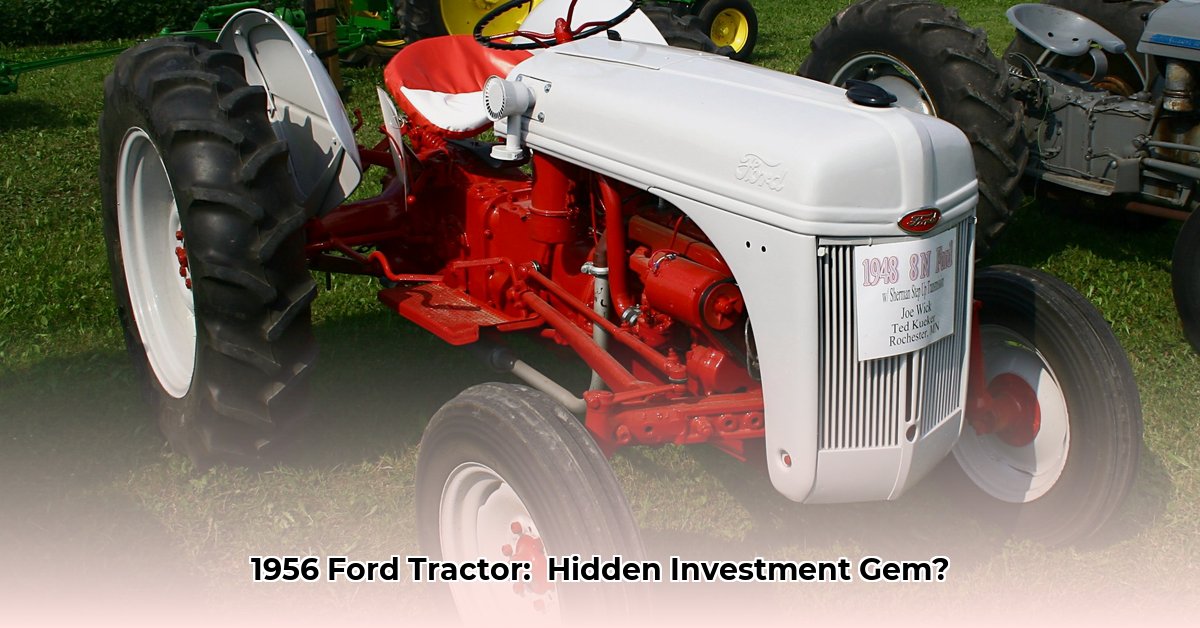
A Piece of Farming History, Now a Collector's Dream
The rhythmic chug of a vintage Ford tractor isn't just a sound; it's a testament to a bygone era of American agriculture. For collectors, the 1956 Ford tractor, particularly the iconic 860 model, represents more than just machinery; it's a tangible piece of history, a robust workhorse, and a potentially lucrative investment. But navigating this niche market requires understanding the factors that drive value and discerning the subtle differences between a worthwhile acquisition and a costly restoration project. This article delves into the world of 1956 Ford tractors, exploring their market trends, influencing factors, and providing actionable advice for buyers, sellers, and researchers alike. For detailed identification help, check out this helpful resource: Ford Tractor IDs.
Unlocking the Value Code: Why Prices Vary So Much
The price of a 1956 Ford tractor can fluctuate dramatically, ranging from a few thousand dollars to over ten thousand. This isn't simply random; several key factors influence a tractor’s worth. Aren't you curious to learn what separates a $3,500 find from a $10,500 prize?
Model Matters: The 860 model stands out, commanding higher demand due to its popularity and features. Rarity plays a crucial role—certain models are simply less common than others. This is analogous to collectible cards: a rare card is worth significantly more than the common.
Condition is Paramount: The condition of a 1956 Ford tractor directly impacts its value. A meticulously restored tractor, gleaming with fresh paint and a smoothly running engine, will fetch a premium compared to a neglected machine. This is similar to the classic car market, where pristine condition often doubles or triples the value.
Desirable Features: Features like a front-mounted loader dramatically enhance a tractor's appeal. A loader transforms the 860 from a basic workhorse into a highly versatile machine, substantially increasing its desirability and value. A functional Power Take-Off (PTO) system (a shaft that transmits power to external equipment) further boosts its worth.
Operational Hours: The operational hours of a tractor serve as an indicator of its overall condition and wear. A tractor with low hours commands a higher price than one showing extensive usage. Low hours suggest better maintenance and less wear and tear; these are major selling points.
Market Snapshot: What the Data Suggests (So Far)
Preliminary data analysis reveals a broad price range for 1956 Ford tractors, generally between $3,500 and $10,500. However, this data is still under development. Further research, including a more comprehensive dataset, is needed to provide a more accurate and robust statistical analysis. The observed variance perfectly reflects the impact of the previously mentioned factors.
Smart Strategies for Buyers, Sellers, and Researchers
Navigating the 1956 Ford tractor market requires a strategic approach. The following strategies cater to different stakeholders:
For Collectors:
Thorough Research: Prior to any purchase, conduct extensive research, comparing prices across different platforms and examining available historical information. A pre-purchase inspection by a qualified mechanic is crucial.
Seek Desirable Features: Prioritize tractors with loaders and PTOs. These features significantly increase value and functionality.
- Patient Acquisition: Finding the right tractor may take time. Don't rush into a purchase; patience often yields the best results.
For Dealers & Resellers:
Strategic Pricing: Use comparable sales data to price tractors competitively. Overpricing can deter potential buyers.
Restoration Expertise: Investing in tractor restoration skills significantly increases profitability. A well-restored tractor will always command a higher price; it is almost a guaranteed return on investment.
Effective Marketing: Use high-quality photos, detailed descriptions, and targeted advertising to reach the right buyer demographic.
For Researchers:
- Data Expansion: Collect more sales data encompassing a broader range of models and geographical locations to refine market analysis.
- Statistical Analysis: Employ statistical techniques (like regression analysis) to correlate specific features with price fluctuations.
- Long-Term Trend Analysis: Track market trends over time to identify patterns and predict future price movements.
The Potential Pitfalls: Managing the Risks
Investing in vintage tractors presents inherent risks:
| Risk Factor | Mitigation Strategy |
|---|---|
| Overpaying | Thorough inspection, professional appraisal |
| Mechanical Problems | Pre-purchase inspection by a qualified mechanic |
| Market Fluctuations | Diversified investment portfolio |
| Authenticity Issues | Verify the tractor's history and check for original parts |
The Future of the 1956 Ford Tractor Market: Where Are We Headed?
The 1956 Ford tractor market exhibits a dynamic nature. The limited supply coupled with increased collector interest suggests potential price appreciation, particularly for rare and well-maintained models. However, broader economic factors and evolving collector preferences could influence market trends. Thorough research and careful consideration are paramount for success in this niche market.